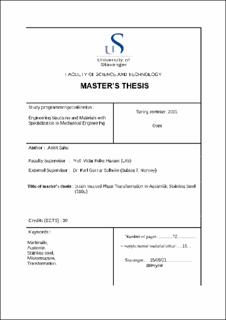| dc.description.abstract | The purpose of the thesis is to investigate the amount of deformation induced martensite in AISI 316L austenitic stainless steel. Deformation condition used for this work are cyclic strain, tensile failure at room temperature with low (0.0005 per second) and high (200 per second) strain rates and tensile failure of material at depressed (-80°C, -40°C) and elevated temperature (100°C). Austenitic stainless steel (ASS) has the tendency to transform from metastable austenite phase to thermodynamically more stable alpha-martensite due to plastic deformation. Thesis topic was proposed by Subsea7, Norway and their main area of interest was to see if any martensite is induced at lower strain amplitude under cyclic loading condition because during reeling pipeline operation pipes experiences a cyclic load of up to 2-3% strain amplitude. Apart from cyclically deformed specimen, this work also includes microstructure study of tensile failed specimens at various temperatures.
The material received for experimental work was a section of pipe which had a 3 mm ASS liner inside of the pipe made up of carbon steel to prevent it from corrosion. The section of pipe was first cutted and then machined to form a dogbone like shape according to American society for testing and materials (ASTM) standard to carry out deformation using 250kN INSTRON uniaxial tensile test machine. After the deformation of material at particular test condition it was examined using various microscopy techniques. First microstructure investigation was done using optical microscope (OM) and further it was analyzed using Transmission electron microscope (TEM). Vickers hardness measurement was also carried for all the deformed specimens. X-ray diffraction (XRD) technique was used to find out if any new phase was observed or not.
The microstructure analysis through optical microscope revealed that there was no martensite induced in cyclically deformed specimen (both at lower and higher strain amplitudes), but thenumber of mechanical twin’s were increased with increasing strain amplitude. Also this finding was supported by TEM, XRD, hardness value and ferritescope analysis. On the other hand,the microstructure of tensile failed specimen revealed that the austenite grain boundary is not stable and their might be induced martensite formation as perceived from the image analysis using optical microscope. Due to limitation of lab facility at the university it was not possible to measure the magnetic parameters of tensile failed specimen which is an important area to be known for this work because austenite steel is non-magnetic in nature but the induced martensite is magnetic in nature. TEM diffraction pattern was investigated but it was difficult to get any diffraction pattern for martensite in tensile failed specimen which may be attributed to low amount of induced martensite. The influence of applied stress and the stacking fault energyon the formation of shear bands, acts as the nucleation sites for induced martensite. It was seen that the strain-induced martensite transformation was suppressed with increasing strain rate and temperature in the tensile failed specimen, due to temperature dependence of the stacking fault energy. Under various temperature of examination it was seen that the maximum amount of induced martensite was found to occur at lower temperature (-80°C) and minimum at elevated temperature (100°C) for tensile failed specimen.
Keywords: Martensite, Austenite, Stainless steel, Microstructure, Transformation. | |
